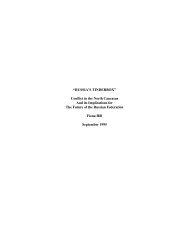The Heart of the Matter Valerie M. Hudson, - MIT Press Journals
The Heart of the Matter Valerie M. Hudson, - MIT Press Journals
The Heart of the Matter Valerie M. Hudson, - MIT Press Journals
Create successful ePaper yourself
Turn your PDF publications into a flip-book with our unique Google optimized e-Paper software.
<strong>The</strong> <strong>Heart</strong> <strong>of</strong> <strong>the</strong> <strong>Matter</strong> 19<br />
patrilocality, early to mid-teen marriage for females—may have been <strong>the</strong> ªrst,<br />
critical steps to eventually breaking <strong>the</strong> political power <strong>of</strong> such hierarchies. Although<br />
in <strong>the</strong> initial stages <strong>the</strong> rise <strong>of</strong> democracy did not facilitate women’s<br />
political power, without an adjustment in <strong>the</strong> fundamental character <strong>of</strong> malefemale<br />
relations, <strong>the</strong>se scholars assert that democracy may never have been a<br />
historical possibility for humans. And as norms <strong>of</strong> democracy arose, <strong>the</strong> stage<br />
was set for women to achieve political power. If <strong>the</strong>se <strong>the</strong>orists are correct,<br />
<strong>the</strong>n levels <strong>of</strong> violence against women should be more predictive <strong>of</strong> state security<br />
and peacefulness than levels <strong>of</strong> procedural democracy. In o<strong>the</strong>r words, in<br />
states where democracy arose from within through <strong>the</strong> amelioration <strong>of</strong> gender<br />
inequality, we should ªnd greater state security; but where democracy was imposed<br />
or veneered over systems where male-female relations did not undergo<br />
fundamental transformation, we should not ªnd as signiªcant differences in<br />
state security and peacefulness.<br />
Just as a proclivity toward international peace in democratic societies is<br />
based, in part, “on tolerance and a respect for <strong>the</strong> rights <strong>of</strong> opponents,” 37 so<br />
scholars might also contemplate that norms <strong>of</strong> gender-based violence have an<br />
inºammatory impact on domestic and international behavior. For example,<br />
studies have shown that if domestic violence is normal in family conºict resolution<br />
in a society, <strong>the</strong>n that society is more likely to rely on violent conºict resolution<br />
and to be involved in militarism and war than are societies with lower<br />
levels <strong>of</strong> family violence. 38 A vicious circle may result, where such state<br />
violence may in turn lead to higher levels <strong>of</strong> gender violence. 39 Indeed, lower<br />
<strong>the</strong> Making <strong>of</strong> History: A Subversive View <strong>of</strong> <strong>the</strong> Western Past (Cambridge: Cambridge University<br />
<strong>Press</strong>, 2004); and Jack P. Greene and J.R. Pole, eds., Colonial British America: Essays in <strong>the</strong> New History<br />
<strong>of</strong> <strong>the</strong> Early Modern Era (Baltimore, Md.: Johns Hopkins University <strong>Press</strong>, 1983).<br />
37. Gregory A. Raymond, “International Norms: Normative Orders and Peace,” in John A.<br />
Vasquez, ed., What Do We Know about War? (New York: Rowman and Littleªeld, 2000), pp. 281–<br />
297, at p. 290.<br />
38. Gerald M. Erchak, “Family Violence,” in Carol R. Ember and Melvin Ember, eds., Research<br />
Frontiers in Anthropology (Englewood Cliffs, N.J.: Prentice-Hall, 1994); Gerald M. Erchak and Richard<br />
Rosenfeld, “Societal Isolation, Violent Norms, and Gender Relations: A Reexamination and Extension<br />
<strong>of</strong> Levinson’s Model <strong>of</strong> Wife Beating,” Cross-Cultural Research, Vol. 28, No. 2 (May 1994),<br />
pp. 111–133; David Levinson, Family Violence in Cross-Cultural Perspective (Newbury Park, Calif.:<br />
Sage, 1989); and Cynthia Cockburn, “<strong>The</strong> Gendered Dynamics <strong>of</strong> Armed Conºict and Political Violence,”<br />
in Caroline O.N. Moser and Fiona C. Clark, eds., Victims, Perpetrators, or Actors? Gender,<br />
Armed Conºict, and Political Violence (New York: Zed, 2001), pp. 13–29.<br />
39. Jean Bethke Elshtain, Women and War (New York: Basic Books, 1987); Betty A. Reardon, Sexism<br />
and <strong>the</strong> War System (New York: Teachers College <strong>Press</strong>, 1985); Sara Ruddick, “Pacifying <strong>the</strong> Forces:<br />
Drafting Women in <strong>the</strong> Interests <strong>of</strong> Peace,” Signs, Vol. 8, No. 3 (Spring 1983), pp. 471–489; and Susan<br />
Brownmiller, Against Our Will: Men, Women, and Rape (New York: Simon and Schuster, 1975).
















